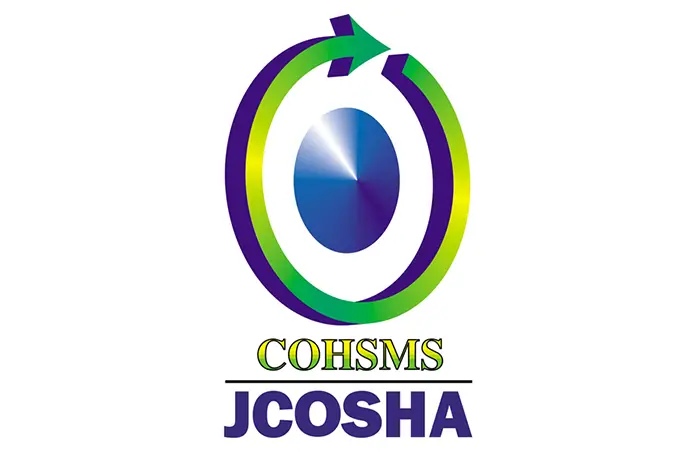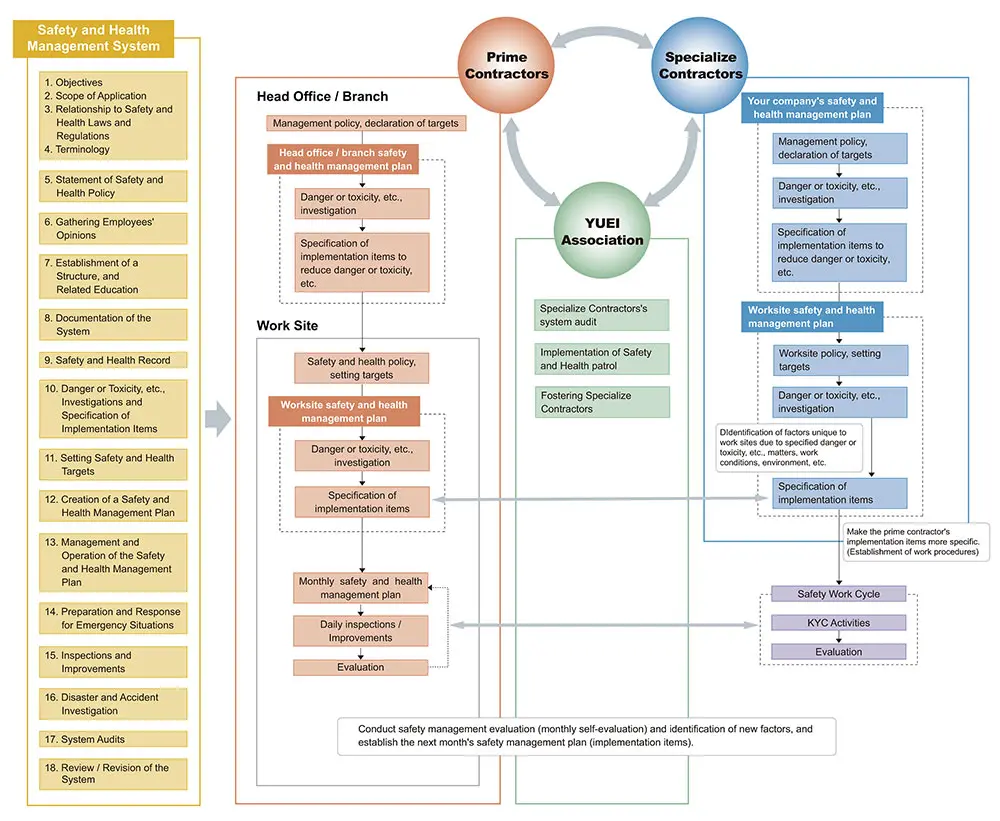Safety and Health Management System
Safety and Health Policy and Management System
In the conduct of its business, the Kumagai Gumi Group prioritizes respect for human life and maintains high health and safety management standards to prevent labor accidents, improve health, and create comfortable working environments.
We comply with social norms, laws, our internal standards, and other rules, and have established a Safety and Health Management System which we operate with high effectiveness.
- Average frequency during the Medium-Term Management Plan period: 0.5 or less
(Average frequency from FY2018 to FY2020: 0.48) - FY2021 safety and health targets: Fatal accidents: 0;
Frequency of fatal accidents: 0.5 or less
Kumagai Gumi led the industry by adopting the Kumagai Gumi Occupational Safety and Health Management System (OSHMS) in 1999. Since then, our safety performance has steadily improved and the system has greatly contributed as a method for preventing occupational accidents.

COHSMS Certification
The Japan Construction Occupational Safety and Health Association started the COHSMS (Construction Occupational Health and Safety Management System) certification business from 2008 in order to widely spread the "Policy on Occupational Safety and Health Management Systems" published by the Ministry of Health, Labour and Welfare in April 1999.
Kumagai Gumi has obtained company-wide certification #1, and has since updated the certification each year by receiving an examination.
System Features
- System unified over the entire company (company standard)
- Conducting risk assessment via a database of disaster information and safety and health patrol information
- Including guidance and education for specialized contractors and clarifying responsibilities
- Enhancing our line and staff management system (clarifying the responsibilities of each department)
- Streamlining the saving of safety and health records

Line and staff management system to enhance awareness on the prevention of occupational accidents
Adopting this system has enabled safety management to also be executed for the construction department line with clearly defined roles and responsibilities and positioned the safety department within company staff to improve our safety performance.
Educating employees on safety and health and enhancing system operation
Safety and health education is positioned as an important factor for preventing occupational accidents, and we strive to improve knowledge regarding safety and health management, system operation, and problems and improvement measures, etc.
- Branch office safety and health education
8 hours or more of education every year - Head office safety and health education
2 or 3 days of education 5 years, 9 years, and 21 years after entering the company
Verifying the PDCA cycle
It is important to operate the system well in order to prevent occupational accidents. System audits are conducted by auditors in order to understand the system and verify whether it is operated according to the safety and health management plan.
Status of labor accidents
| (total at the end of each fiscal yeal) | FY2019 | FY2020 | FY2021 | FY2022 | FY2023 |
|---|---|---|---|---|---|
| Frequency | 0.44 | 0.32 | 0.63 | 0.69 | 0.98 |
| Severity | 0.02 | 0.28 | 0.10 | 0.77 | 0.39 |
| Number of accidents resulting in 4 or more days off work (deaths) | 13 cases | 9 cases(1) | 16 cases | 15 cases(2) | 22 cases |
Sharing of safety and health information and prevention of the recurrence of accidents and incidents
To enforce the sharing of safety and health information and prevention of the recurrence of accidents and incidents, we introduced the Safety Portal System in April 2021 and worked to accumulate and centralize data.
We will also create a database of the results of daily safety and health patrols, and will develop a system for drafting workplace Safety and Health Control Plans.
Safety education for employees
We established educational guidelines to improve the labor/occupational health and safety management capabilities of our employees, and conduct occupational Headquarters and branches. While we were unable to conduct our usual group education in fiscal 2020 due to the COVID-19 pandemic, we refined and carried out online education and e-learning.
The possibilities have expanded for new teaching methods that are effective and efficient.
Initiatives concerning foreign workers
Many foreign workers are active in the construction industry, and labor accidents involving these workers have increased accordingly.
We have translated our Workers' Basic Education booklet into foreign languages to provide basic safety and health knowledge and are supporting education for business operators. We are aiming to create safe and secure workplace environments or foreign workers by means including creating foreign language versions of the materials for occupational health and safety education performed when entering work sites, to promote understanding of workplace rules.
Initiatives for safe work by elderly persons
We are strengthening initiatives to protect seniors, including placement of "thoughtfulness stickers" that encourage surrounding workers to warm to elderly persons, visualization of fall prevention measures, setting of age limits and permission systems for work that involves a risk of falls, and awareness education that encourages elderly persons to make use of their abundant experience while instilling self-awareness of physical weakening.
Through such efforts, in recent years we have reduced accidents involving elderly persons, which had been on the rise.
